Land Cover Mapping using Digital Earth Australia
Abstract
:1. Introduction
2. Aims
3. Background to EODESM
3.1. Land Cover Classification
3.2. Change Detection
4. Study Sites
4.1. Lower Burdekin (Townsville and Ayr), Queensland
4.2. Diamantina, Queensland
4.3. Gwydir, New South Wales
4.4. Southwest Gulf of Carpentaria, Queensland and the Leichhardt River
5. Methods
5.1. Available Data
5.2. Input Layers for EODESM
5.3. Implementation of the Land Cover Classification
5.3.1. Segmentation
5.3.2. Classification
5.3.3. Evidence-Based Change Detection
6. Results
6.1. Land Cover Classifications
6.2. Land Cover Change Maps
6.3. Evidence-Based Change Descriptions
7. Discussion
7.1. Overview of Approach
7.2. Application within the DEA
8. Conclusions
Author Contributions
Funding
Acknowledgments
Conflicts of Interest
References
- Geoscience Australia. 2011. Available online: https://ecat.ga.gov.au/geonetwork/srv/eng/catalog.search#/metadata/71069 (accessed on 16 October 2019).
- International Organization for Standardization. 2018. Available online: https://www.iso.org/standard/44342.html (accessed on 16 October 2019).
- Atyeo, C.; Thackway, R. A Field Manual for Describing and Mapping Revegetation Activities in Australia; Bureau of Rural Sciences: Canberra, Australia, 2009. [Google Scholar]
- Lewis, A.; Oliver, S.; Lymburner, L.; Evans, B.; Wyborn, L.; Mueller, N.; Raevksi, G.; Hooke, J.; Woodcock, R.; Sixsmith, J.; et al. The Australian geoscience data cube-Foundations and lessons learned. Remote Sens. Environ. 2017, 202, 276–292. [Google Scholar] [CrossRef]
- Lucas, R.M.; Blonda, P.; Bunting, P.; Jones, G.; Inglada, J.; Aria, M.; Kosmidou, V.; Petrou, Z.I.; Manakos, I.; Adamo, M.; et al. The Earth Observation Data for Habitat Monitoring (EODHAM) System. Int. J. Appl. Earth Obs. Geoinform. 2014, 37, 17–28. [Google Scholar] [CrossRef]
- Lucas, R.M.; Medcalf, K.; Brown, A.; Bunting, P.; Breyer, J.; Clewley, D.; Keyworth, S.; Blackmore, P. Updating the Phase 1 habitat map of Wales, UK, using satellite sensor data. ISPRS J. Photogramm. Remote Sens. 2011, 66, 81–102. [Google Scholar] [CrossRef]
- EcoPotential NGO. Available online: https://www.ecopotential-project.eu (accessed on 16 October 2019).
- Lucas, R.M.; Mitchell, A. Integrated Land Cover and Change Classifications. In The Roles of Remote Sensing in Nature Conservation: A Practical Guide and Case Studies; Díaz-Delgado, Lucas, R., Hurford, C., Eds.; Springer: Cham, Switzerland, 2017; pp. 295–308. [Google Scholar]
- Lucas, R.M. The Earth Observation Data for Ecosystem Monitoring (EODESM). Available online: https://essilab.wixsite.com/eodesm (accessed on 16 October 2019).
- Bunting, P.; Clewley, D.; Lucas, R.M.; Gillingham, S. The Remote Sensing and GIS Software Library (RSGISLib). Comput. Geosci. 2014, 62, 206–226. [Google Scholar] [CrossRef]
- Bunting, P.; Gillingham, S. The KEA image file format. Comput. Geosci. 2013, 57, 54–58. [Google Scholar] [CrossRef]
- Verbesselt, J.; Hyndman, R.; Zeileis, A.; Culvenor, D. Phenological change detection while accounting for abrupt and gradual trends in satellite image time series. Remote Sens. Environ. 2010, 114, 2970–2980. [Google Scholar] [CrossRef] [Green Version]
- Tarantino, C.; Adamo, M.; Lucas, R.; Blonda, P. Detection of changes in semi-natural grasslands by Cross Correlation Analysis with WorldView-2 images and new Landsat 8 data. Remote Sens. Environ. 2016, 175, 65–72. [Google Scholar] [CrossRef] [PubMed]
- Gill, T.; Johansen, K.; Phinn, S.; Trevithick, R.; Scarth, P.; Armston, J. A method for mapping Australian 584 woody vegetation cover by linking continental-scale field data and long-term Landsat time series. Int. J. Remote Sens. 2017, 38, 679–705. [Google Scholar] [CrossRef]
- Sagar, S.; Roberts, D.; Bala, B.; Lymburner, L. Extracting the intertidal extent and topography of the Australian coastline from a 28 year time series of Landsat observations. Remote Sens. Environ. 2017, 195, 153–169. [Google Scholar] [CrossRef]
- Lymburner, L.; Bunting, P.; Lucas, R.; Scarth, P.; Alam, I.; Phillips, C.; Ticehurst, C.; Held, A. Mapping the multi-decadal mangrove dynamics of the Australian coastline. Remote Sens. Environ. 2019. [Google Scholar] [CrossRef]
- Mueller, N.; Lewis, A.; Roberts, D.; Ring, S.; Melrose, R.; Sixsmith, J.; Lymburner, L.; McIntyre, A.; Tan, P.; Curnow, S.; et al. Water observations from space: Mapping surface water from 25 years of Landsat imagery across Australia. Remote Sens. Environ. 2016, 174, 341–352. [Google Scholar] [CrossRef]
- ABARES. The Australian Land Use and Management Classification Version 8; CC BY 3.0; Australian Bureau of Agricultural and Resource Economics and Sciences: Canberra, Australian, 2016.
- Scarth, P.; Armston, J.; Lucas, R.; Bunting, P. A Structural Classification of Australian Vegetation Using ICESat/GLAS, ALOS PALSAR, and Landsat Sensor Data. Remote Sens. 2019, 11, 147. [Google Scholar] [CrossRef]
- Australian DoEE. Available online: https://www.environment.gov.au/ (accessed on 16 October 2019).
- Bunting, P.; Rosenqvist, A.; Lucas, R.; Rebelo, L.M.; Hilarides, L.; Thomas, N.; Hardy, A.; Itoh, T.; Shimada, M.; Finlayson, C. The Global Mangrove Watch-a New 2010 Baseline of Mangrove Extent. Remote Sens. 2018, 10, 1669. [Google Scholar] [CrossRef]
- Duke, N.C.; Kovacs, J.M.; Griffiths, A.D.; Preece, L.; Hill, D.J.; Van Oosterzee, P.; Mackenzie, J.; Morning, H.S.; Burrows, D. Large-scale dieback of mangroves in Australia’s Gulf of Carpentaria: A severe ecosystem response, coincidental with an unusually extreme weather event. Mar. Freshw. Res. 2017, 68, 1816–1829. [Google Scholar] [CrossRef]
- Clewley, D.; Bunting, P.; Shepherd, J.; Gillingham, S.; Flood, N.; Dymond, J.; Lucas, R.; Armston, J.; Moghaddam, M. A Python-Based Open Source System for Geographic Object-Based Image Analysis (GEOBIA) Utilizing Raster Attribute Tables. Remote Sens. 2014, 6, 6111–6135. [Google Scholar] [CrossRef] [Green Version]
- Shepherd, J.D.; Bunting, P.; Dymond, J. Operational large-scale segmentation of imagery based on iterative elimination. Remote Sens. 2019, 11, 658. [Google Scholar] [CrossRef]
- Roberts, D.; McIntyre, A.; Mueller, N. High-dimensional pixel composites from earth observation time series. IEEE Trans. Geosci. Remote Sens. 2017, 55, 6254–6264. [Google Scholar] [CrossRef]
- Hacker, J. Targeted Airborne Data. Available online: http://wiki.auscover.net.au/wiki/Targeted_Airborne_Data. (accessed on 16 October 2019).
- Lucas, R.; Finlayson, C.M.; Bartolo, R.; Rogers, K.; Mitchell, A.; Woodroffe, C.; Asbridge, E.; Ens, E. Historical perspectives on the mangroves of Kakadu National Park. Mar. Freshw. Res. 2017, 69, 1047–1063. [Google Scholar] [CrossRef]
- PlanetLabs. Available online: https://www.planet.com/ (accessed on 16 October 2019).
- The Terrestrial Environment Research Network (TERN) Mangrove Data Portal. Available online: http://wiki.auscover.net.au/wiki/TERN_Mangrove_Data_Portal_and_Monitoring_System (accessed on 25 June 2019).
- Roberts, D.; Dunn, B.; Mueller, N. Open Data Cube Products Using High-Dimensional Statistics of Time Series. In Proceedings of the IGARSS 2018–2018 IEEE International Geoscience and Remote Sensing Symposium, Valencia, Spain, 30 June 2018; pp. 8647–8650. [Google Scholar]
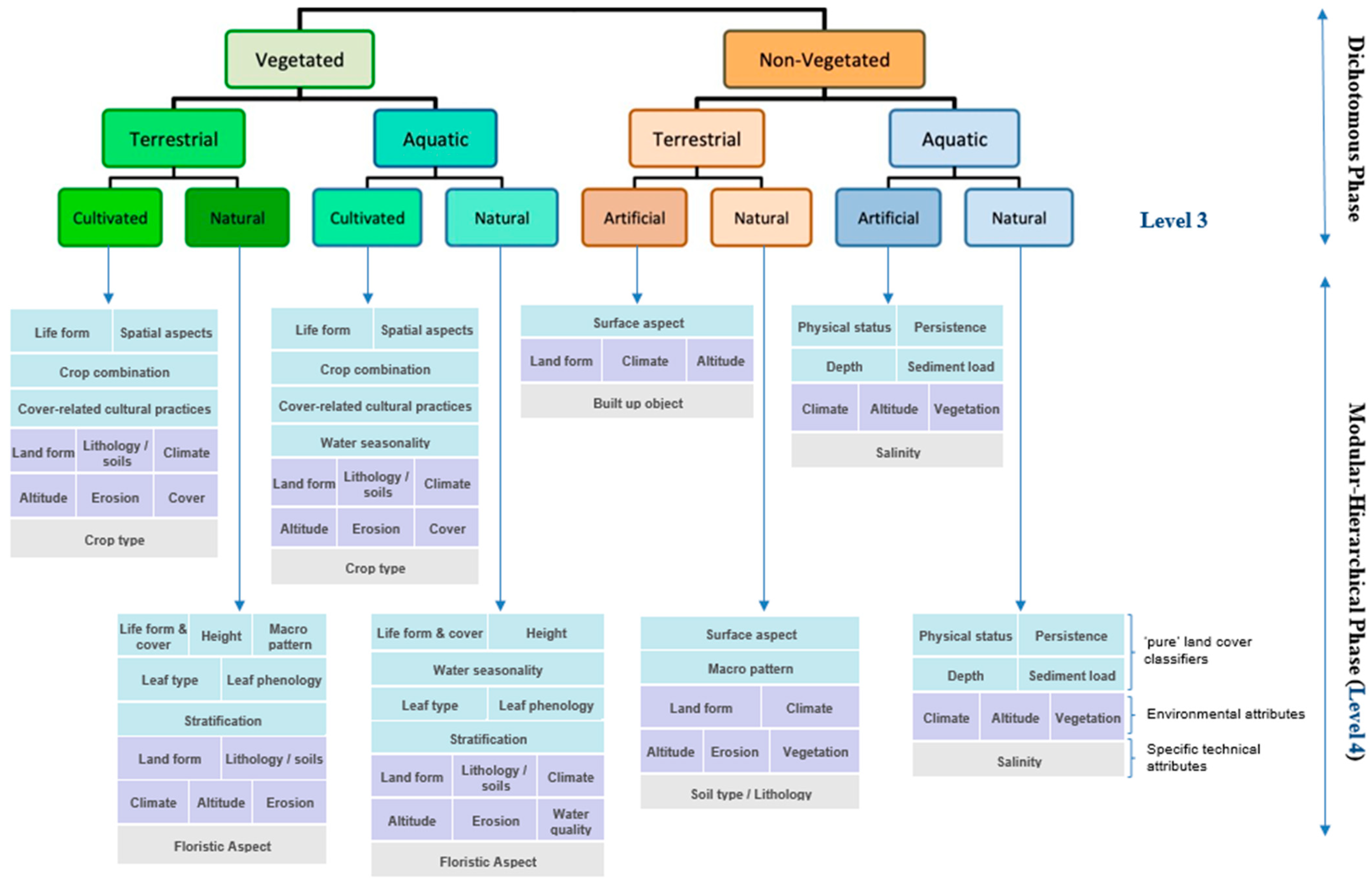
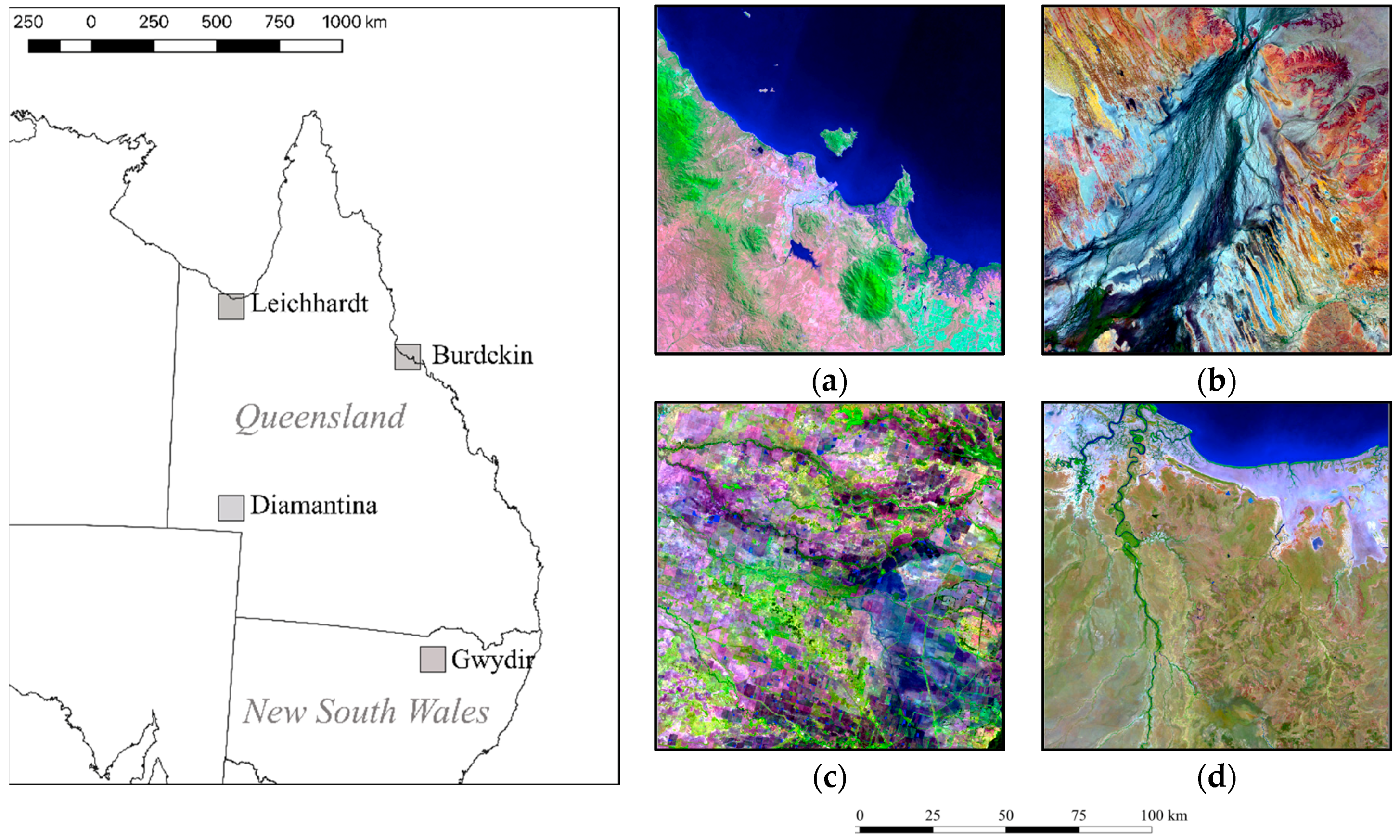


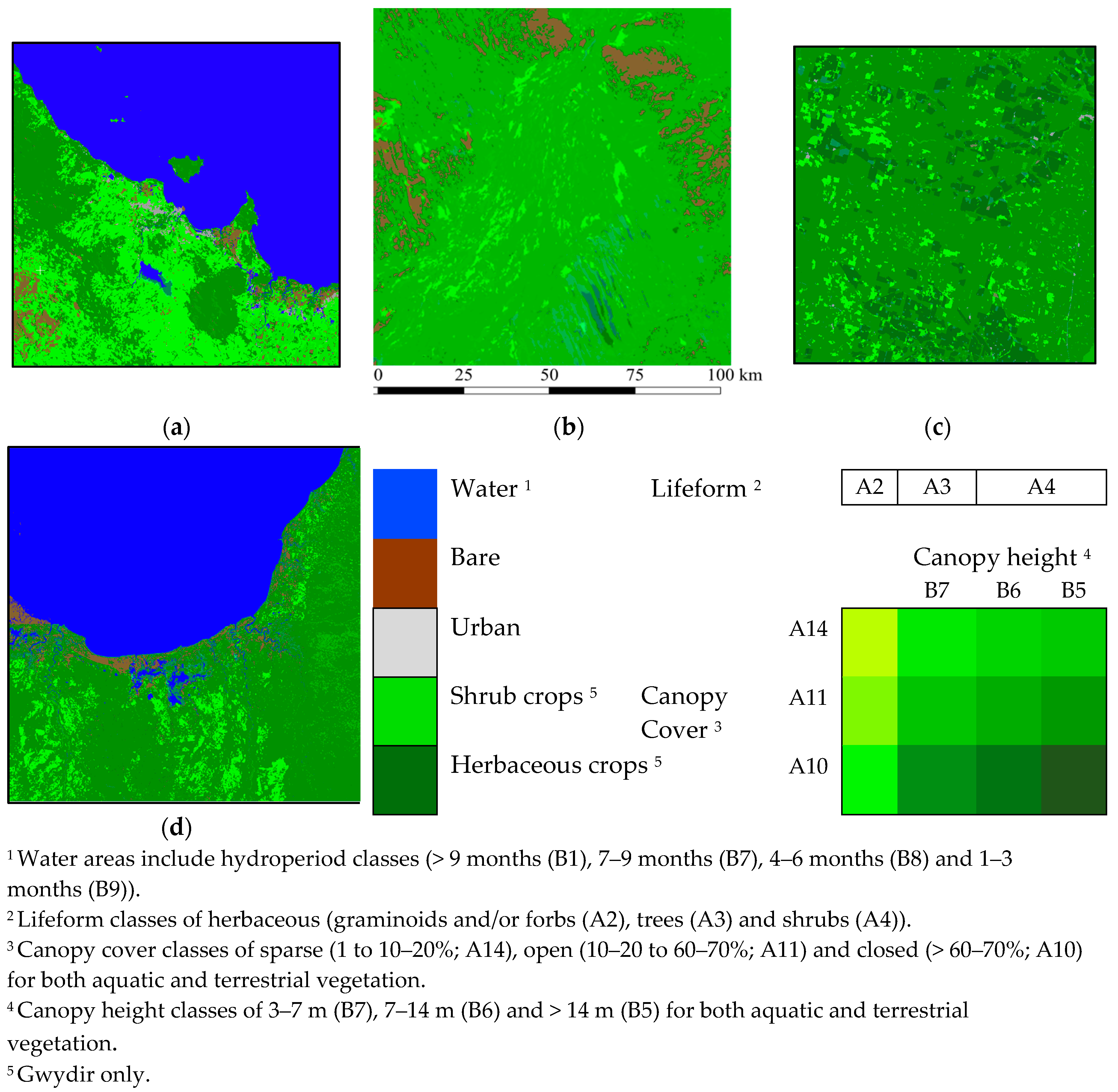
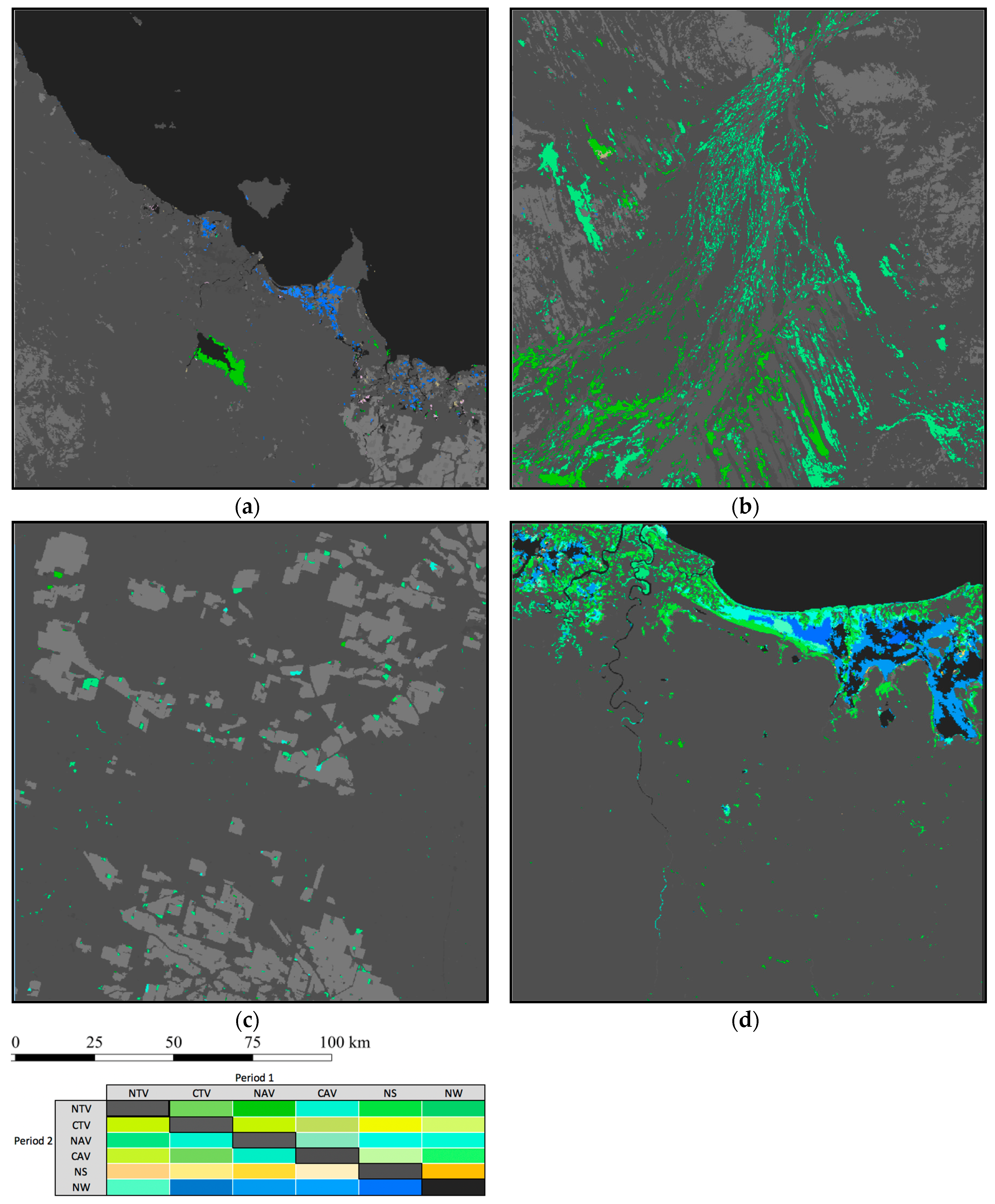
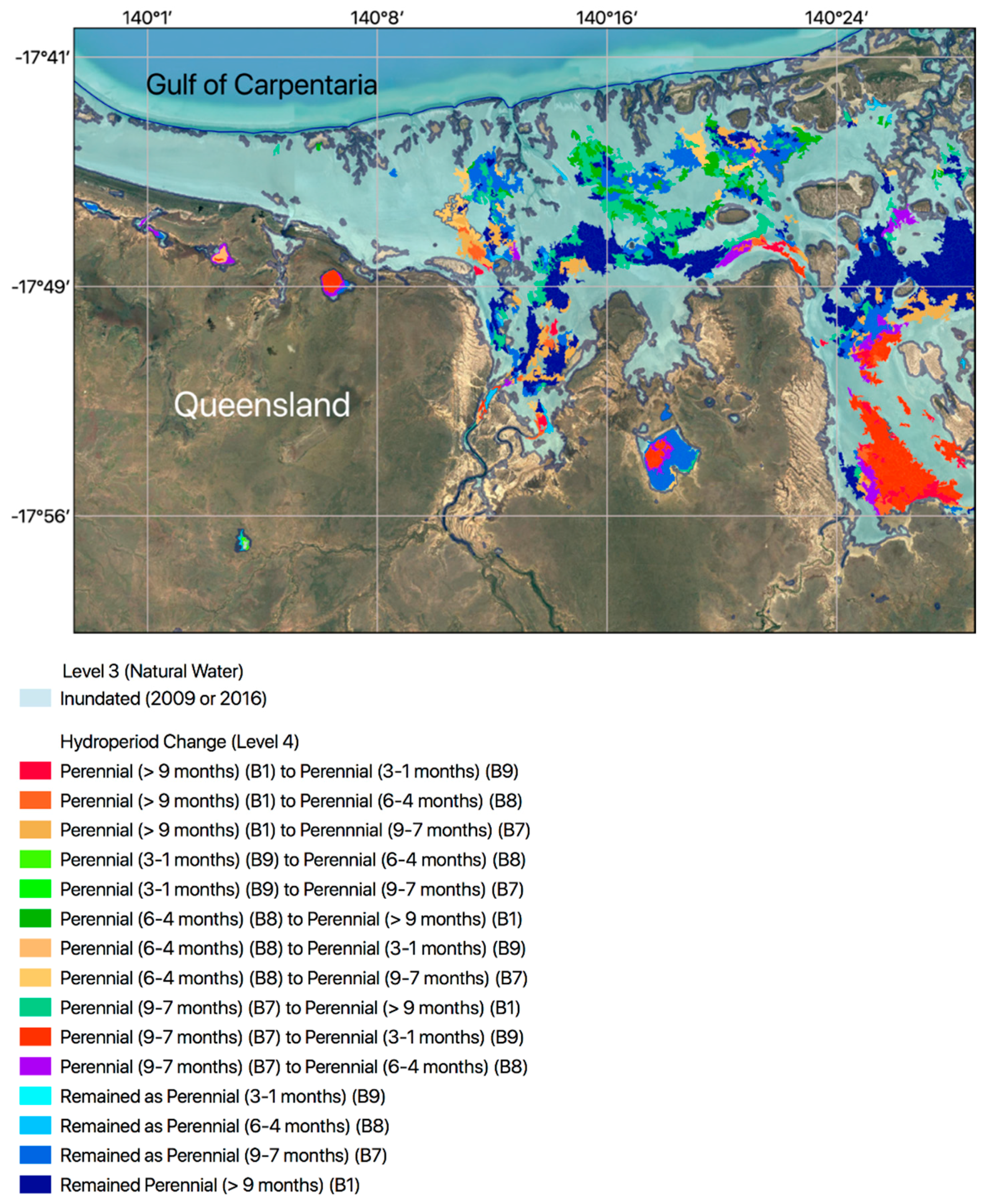
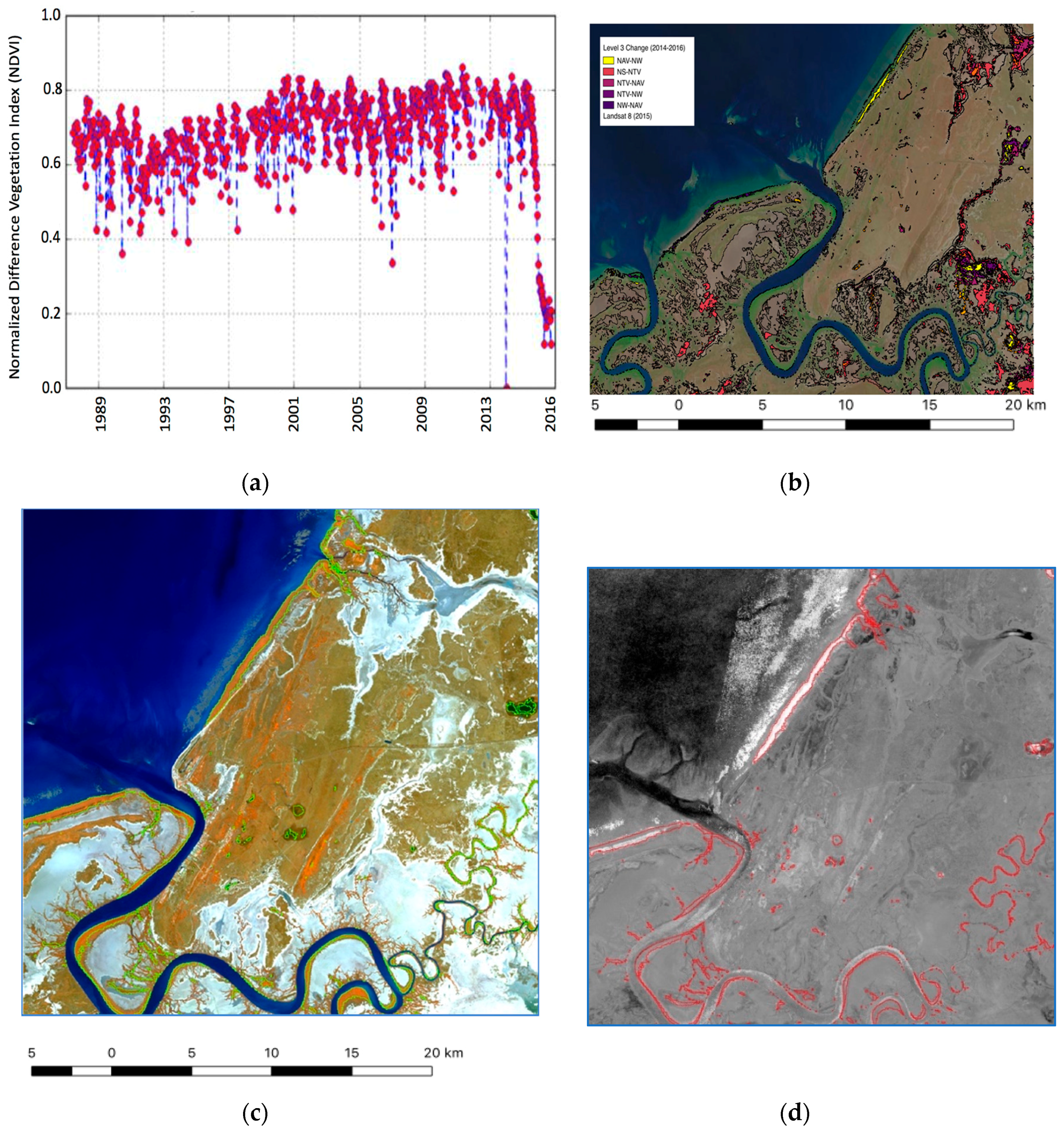
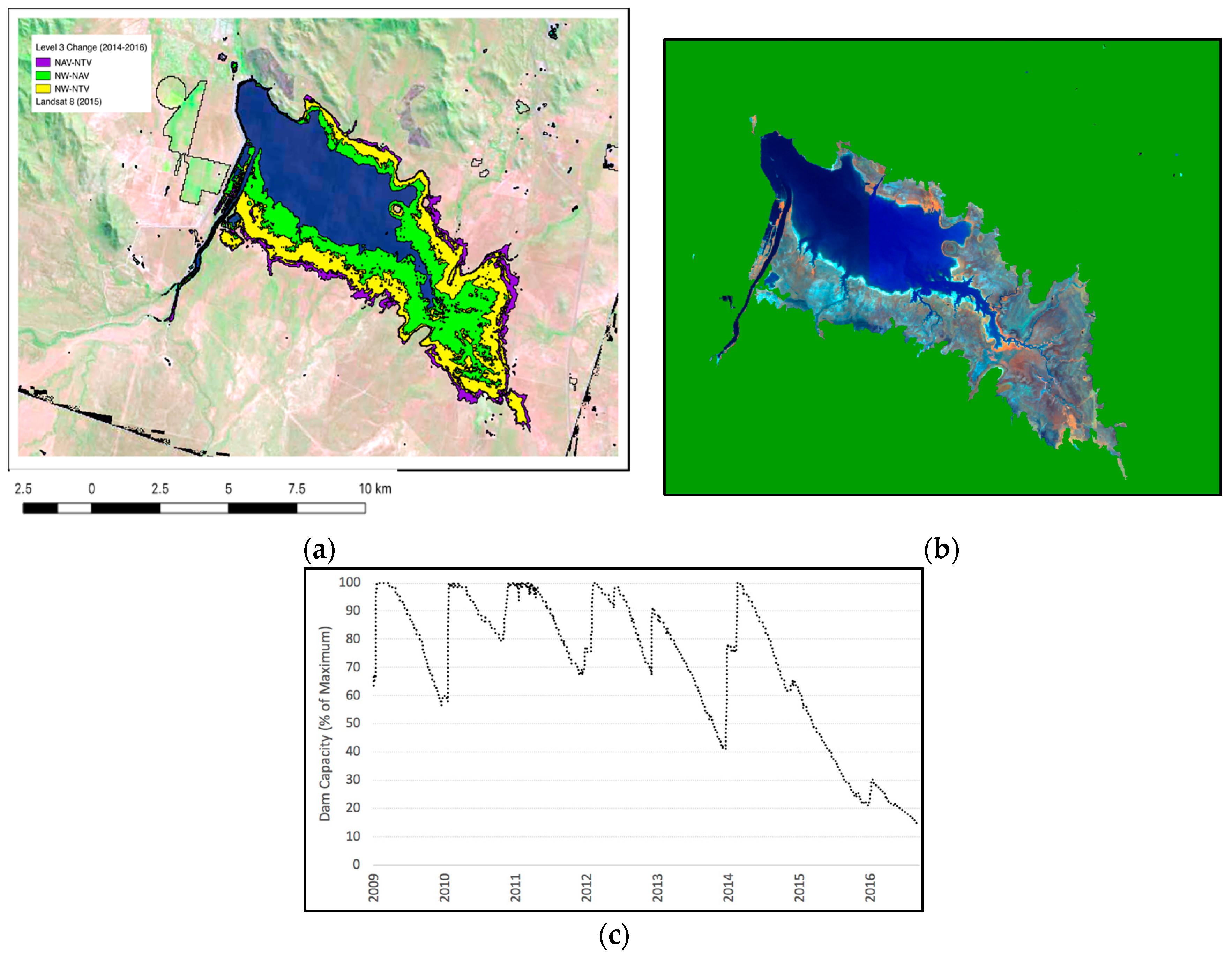
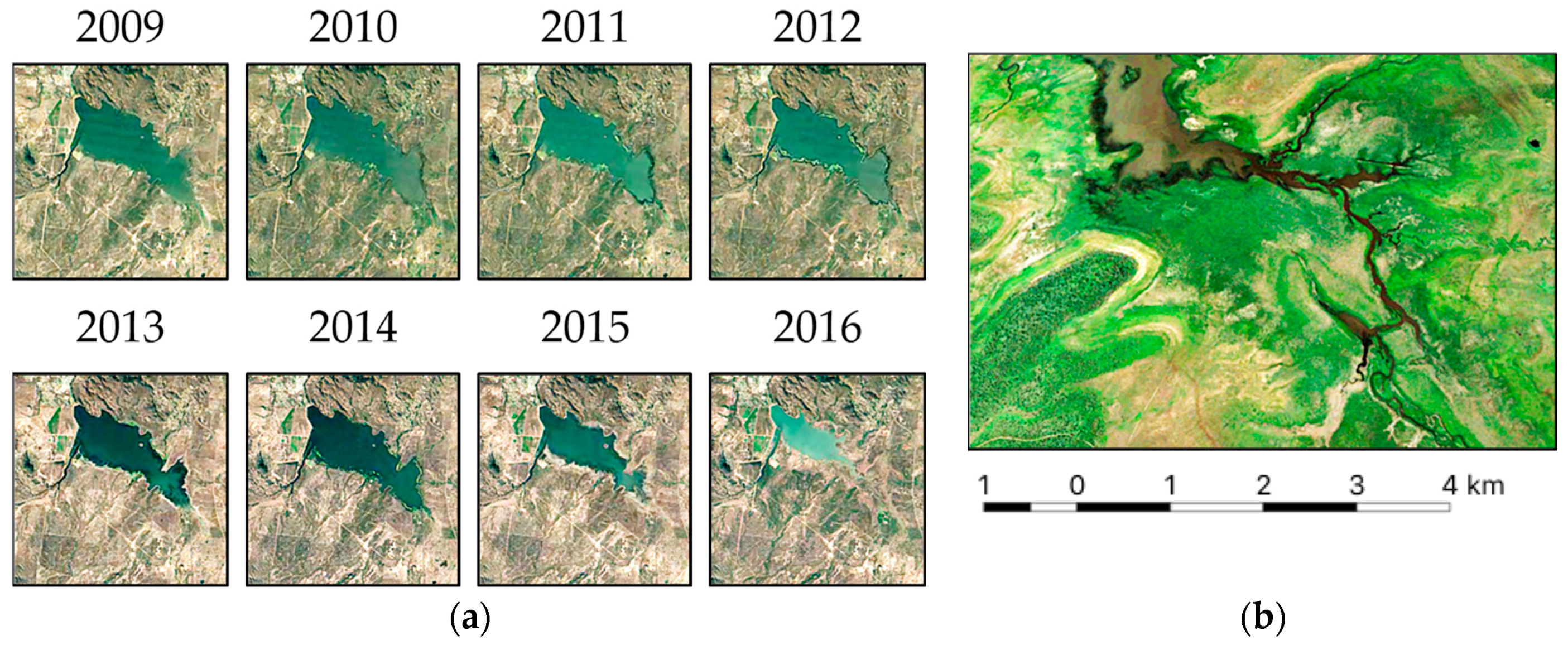
| Data Layer | Type | Derivation | Reference/Source |
|---|---|---|---|
| Fractional cover (photosynthetic and non-photosynthetic vegetation and bare surface) | CO | Spectral unmixing | Gill et al. (2018) [14] |
| Water Observations from Space (WOfS) | CO | Classification | Mueller et al. (2016) [17] |
| Inter-Tidal Extent model (ITEM) | TM | Classification | Sagar et al. (2017) [15] |
| National Mangroves | TM | Classification | Lymburner et al. (2018) [16] |
| Data Layer | Type | Derivation | Reference/Source |
|---|---|---|---|
| TERN Continental Vegetation Height (CVH) | CO | Generated through integration of LiDAR, L-band SAR and Landsat | Scarth et al. (2019) [19] |
| National Vegetation Information System (NVIS) | C) | Collation of State and Territory vegetation maps | Australian Department of the Environment and Energy DOEE [20] |
| Catchment Scale Land Use of Australia | TM | Cultivated areas from cadastral information | Australian Bureau of Agricultural and Resource Economics and Sciences ABARES (2016) [18] |
| TM | Buildings and infrastructure from cadastral information | ||
| Australian Hydrological Geospatial Fabric (Geofabric) | TM | Artificial water (dams and reservoirs) | Bureau of Meteorology |
| Input Layers | Level 3 | Level 4 | EVs |
|---|---|---|---|
| Fractional Cover | Vegetated | Canopy cover | Canopy cover (%) |
| WOfS | Aquatic | Hydroperiod | Hydroperiod (days) |
| ITEM | Aquatic/bare 1 | Tidal extent | Relative tidal inundation frequency (%) |
| GMW Mangroves | Aquatic | Tidal extent | |
| TERN CVH | Lifeform, vegetation (canopy) height | Canopy height (m) | |
| NVIS | Dominant genus | ||
| ABARE | Cultivated | Field size | Field size (ha) Crop type |
| Urban | Density, geometry | Area (%) | |
| Artificial water | Water depth | Water depth (m) |
| EV | Derived Layer | Validation |
|---|---|---|
| Fractional Cover | Vegetated | The fractional cover product has an overall RMSE of 11.8%. The error margins for photosynthetic vegetation, non-photosynthetic vegetation and bare soil fractions are 11.0%, 17.4% and 12.5%, respectively [14]. |
| WOfS | Aquatic | Based on 3.4 million validation points; overall accuracy of 97%; with water identified 93% of time. |
| ITEM | Aquatic/Bare | Mean absolute height difference between (non-inundated) estimated and actual surface elevation of 0.57 m at the continental level. Based on Real Time Kinematic (RTK) Global Positioning Systems (GPS) ground data, with this being indicative of tidal water depth. |
| GMW Mangroves | Aquatic/Vegetated 1 | Users’ and producers’ accuracies from 92–93 and 97–99%, respectively [16]. |
| TERN CVH | Close correspondence with airborne LIDAR profiles from TERN sites [19]. | |
| NVIS | Dominant species 2 | Final accuracy of 85% in the delineation of vegetation map units based on aerial photography at 1:20,000. |
| ABARE 3 | Cultivated | Composite product generated from State and Territory land cover maps with stated overall accuracies above 80% at the catchment scale. |
| Urban | As above | |
| Artificial water | As above |
© 2019 by the authors. Licensee MDPI, Basel, Switzerland. This article is an open access article distributed under the terms and conditions of the Creative Commons Attribution (CC BY) license (http://creativecommons.org/licenses/by/4.0/).
Share and Cite
Lucas, R.; Mueller, N.; Siggins, A.; Owers, C.; Clewley, D.; Bunting, P.; Kooymans, C.; Tissott, B.; Lewis, B.; Lymburner, L.; et al. Land Cover Mapping using Digital Earth Australia. Data 2019, 4, 143. https://doi.org/10.3390/data4040143
Lucas R, Mueller N, Siggins A, Owers C, Clewley D, Bunting P, Kooymans C, Tissott B, Lewis B, Lymburner L, et al. Land Cover Mapping using Digital Earth Australia. Data. 2019; 4(4):143. https://doi.org/10.3390/data4040143
Chicago/Turabian StyleLucas, Richard, Norman Mueller, Anders Siggins, Christopher Owers, Daniel Clewley, Peter Bunting, Cate Kooymans, Belle Tissott, Ben Lewis, Leo Lymburner, and et al. 2019. "Land Cover Mapping using Digital Earth Australia" Data 4, no. 4: 143. https://doi.org/10.3390/data4040143





